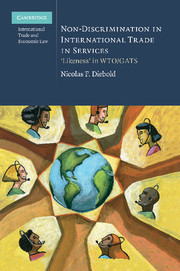Book contents
- Frontmatter
- Contents
- Foreword
- Acknowledgements
- Abbreviations
- List of Cases
- List of Legal Texts
- List of Documents
- Introduction
- PART I Foundations
- PART II Framing the conceptual breadth of ‘likeness’ in GATS
- PART III GATS specific ‘likeness’ issues
- PART IV Methodology for the ‘likeness’ analysis in GATS
- 13 The border tax adjustments framework
- 14 Applying market definition theories to ‘likeness’
- 15 The PPM-problem in the GATS ‘likeness’ context
- 16 Concluding summary: substitutability framework
- Summary of conclusions
- Bibliography
- Index
Summary of conclusions
Published online by Cambridge University Press: 10 January 2011
- Frontmatter
- Contents
- Foreword
- Acknowledgements
- Abbreviations
- List of Cases
- List of Legal Texts
- List of Documents
- Introduction
- PART I Foundations
- PART II Framing the conceptual breadth of ‘likeness’ in GATS
- PART III GATS specific ‘likeness’ issues
- PART IV Methodology for the ‘likeness’ analysis in GATS
- 13 The border tax adjustments framework
- 14 Applying market definition theories to ‘likeness’
- 15 The PPM-problem in the GATS ‘likeness’ context
- 16 Concluding summary: substitutability framework
- Summary of conclusions
- Bibliography
- Index
Summary
This study seeked to develop a theory for the ‘like services and service suppliers’ concept as it is embodied in the GATS non-discrimination obligations of MFN and national treatment, applying primarily a contextual and comparative methodology. As the main results developed in the course of this work have been summarized in a concluding chapter at the end of each of the four parts, this final part completes this book with a concise summary of all conclusions.
The underlying policy choice
Part I highlighted the fact that an interpretation of ‘likeness’ is inevitably linked with the policy question of how permissive or intrusive the non-discrimination principle in WTO law should be construed. The creation of an intrusive form of a non-discrimination principle is a matter of policy choice rather than of legal interpretation and involves institutional and constitutional considerations. The legal interpretative tools are only of limited use for answering such fundamental questions. The text of the non-discrimination provisions does not provide much guidance and in principle allows for a wide spectrum of different forms of non-discrimination. On the very permissive side is an obligation which is limited to the prohibition of nationality-based de jure discrimination, where the existence of a ‘like’ product or service is presumed and the regulatory objectives are considered either as an element of non-discrimination or as grounds for justification.
- Type
- Chapter
- Information
- Non-Discrimination in International Trade in Services‘Likeness' in WTO/GATS, pp. 351 - 356Publisher: Cambridge University PressPrint publication year: 2010

